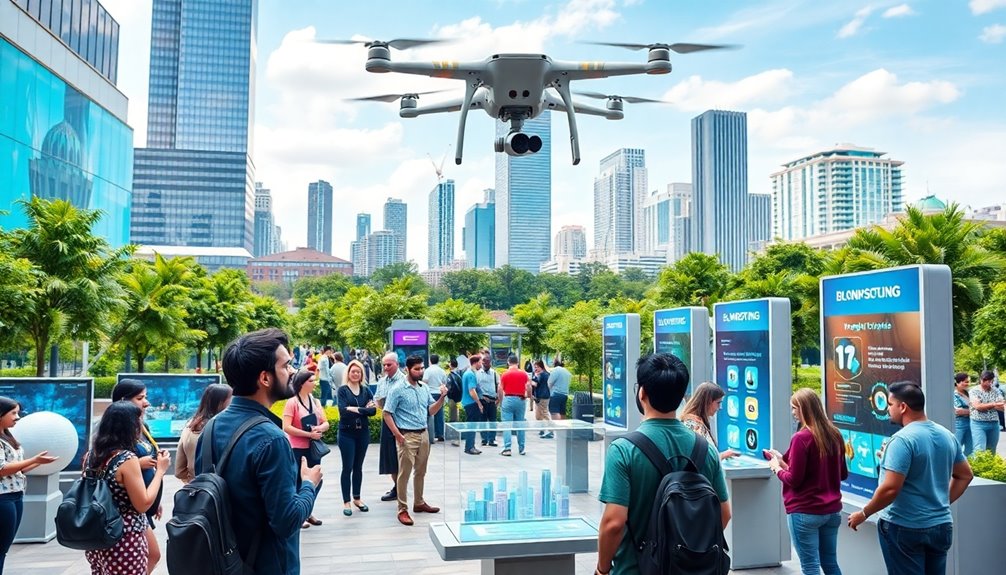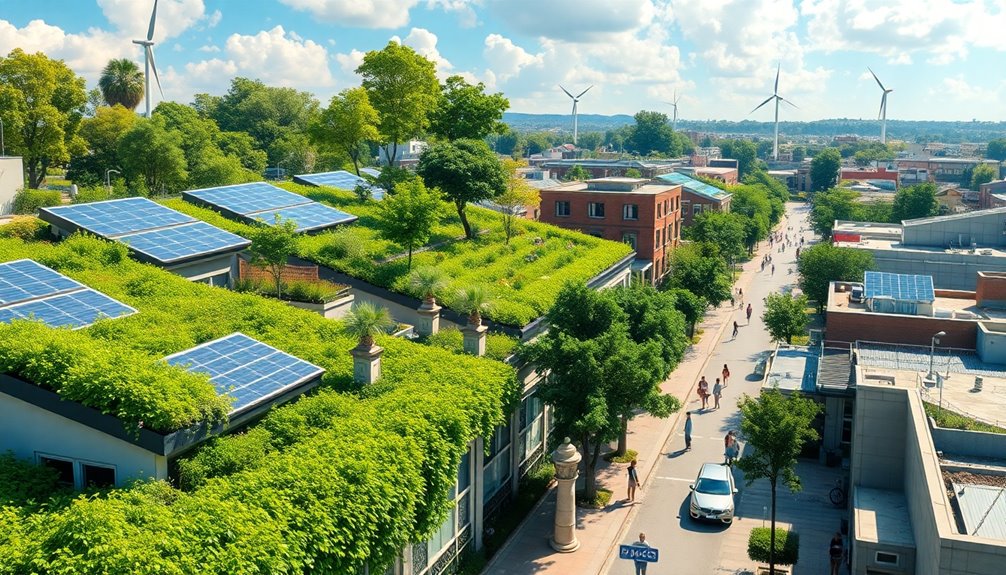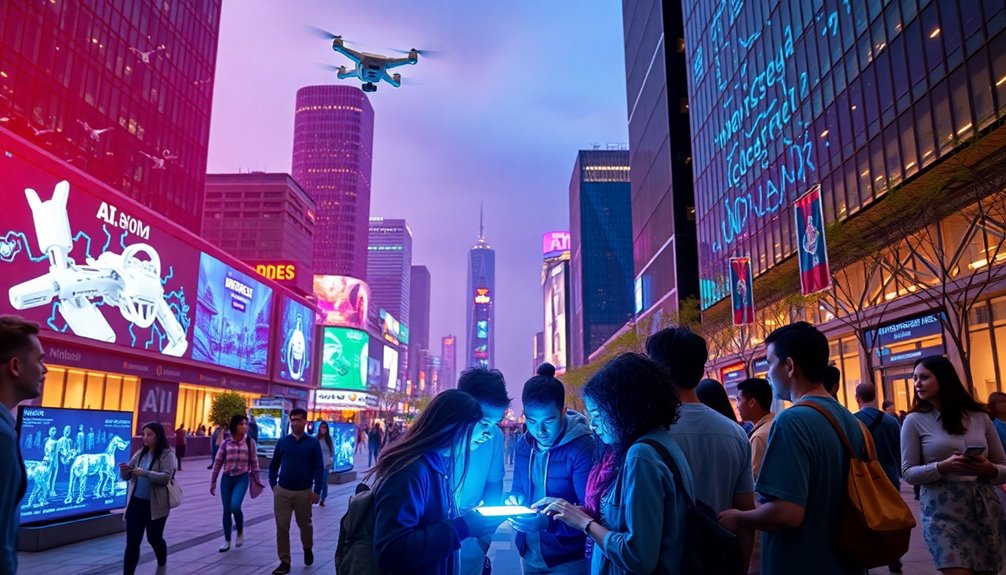Next year, you'll see some exciting billion-dollar trends shaking up industries. AI will dominate, enhancing e-commerce and healthcare while driving personalized experiences. Sustainability becomes a must as consumers demand eco-friendly products. The global startup ecosystem will expand, especially in emerging markets, thanks to innovative funding options. Expect to see shifts in real estate, with millennials pushing demand for affordable homes. Climate change awareness will lead to better resilience strategies. As tech continues evolving, all these trends are set to create a dynamic landscape. Discover how these changes will shape the future around you.
Key Takeaways
- AI technologies will revolutionize industries, enhancing customer experiences and operational efficiencies, projected to add $15.7 trillion to the global economy.
- Sustainability will dominate consumer choices, with increased investment in eco-friendly products and practices, reflecting a 22% rise in sustainable technology investment.
- The subscription economy will thrive, expected to reach a $1 trillion market by 2025, driven by consumer demand for convenience and personalization.
- Emerging markets in Africa and Southeast Asia will see a surge in startup opportunities, supported by enhanced funding and collaboration initiatives.
- Cybersecurity investments will exceed $1 trillion by 2025, driven by the increasing frequency of data breaches and the need for robust protection measures.
The Rise of AI Applications

As AI applications continue to evolve, you're likely to see their impact across various industries firsthand.
Artificial intelligence is revolutionizing sectors like e-commerce and healthcare through predictive analytics and autonomous systems. Startups are at the forefront, creating AI-driven solutions that enhance business operations and personalize customer experiences.
The economic potential is immense, with estimates suggesting AI could add $15.7 trillion to the global economy—transforming it much like steam engines and electricity did in the past. Additionally, AI technologies in agriculture are optimizing crop yields and resource management, showcasing the diverse applications of this technology.
However, as AI becomes more integrated into daily life, ethical considerations and the need for regulatory frameworks become essential.
You'll also notice new job roles emerging, emphasizing the importance of training programs to equip the workforce with the skills necessary for this AI-driven landscape.
Sustainability as a Business Imperative

Sustainability isn't just a trend anymore; it's becoming a vital component of business strategy.
As you navigate this landscape, consider these key factors:
- Investment in sustainable technologies surged 22% in early 2023, focusing on areas like green hydrogen and electric vehicles.
- Startups emphasizing sustainability are gaining consumer loyalty and attracting more investment.
- Collaborations among startups, corporates, and governments are essential to overcome regulatory hurdles and drive innovation.
Global Startup Ecosystem Expansion

While the global startup ecosystem continues to evolve, emerging markets in Africa, Southeast Asia, and Latin America are seizing new opportunities for growth and innovation.
You're witnessing a remarkable global startup ecosystem expansion as these regions enhance access to funding, technology, and mentorship. Startups are tapping into international markets and collaborating across borders, thanks to the rise of cross-border partnerships and virtual accelerators.
This trend allows diverse talent pools to contribute to success regardless of location. Additionally, geopolitical factors are reshaping innovation, especially in defense and technology sectors.
Innovative Funding Approaches

The global startup ecosystem isn't just expanding geographically; it's also evolving in how startups secure funding. As you navigate this landscape, consider these innovative funding approaches for 2024:
- Crowdfunding and revenue-based financing are becoming popular alternatives, offering flexibility and immediate access to capital.
- Corporate venture arms are increasingly backing startups, fostering collaboration and opening new funding channels.
- AI-driven analytics can enhance your pitch, helping you present clear profitability pathways that attract investors.
With competition for funding intensifying, startups like yours must adapt to these trends. Emphasizing transparency and metrics-driven strategies won't only showcase resilience but also greatly improve your chances of securing the necessary capital to thrive in this evolving market. Additionally, exploring freelance sites can provide a supplementary income stream while you seek funding opportunities.
Workforce Evolution and Skills

As industries rapidly evolve, it's essential for you to recognize the shifting landscape of workforce skills.
By 2027, over 50% of jobs will demand new skill sets, driven by technologies like AI and advanced manufacturing. This workforce evolution calls for urgent upskilling initiatives, especially in sectors facing labor shortages, such as construction and healthcare.
With the construction industry needing 500,000 new workers by 2024 and the medical field anticipating a shortfall of 200,000 nurses, targeted training programs are vital.
As economies stabilize, small, agile teams will propel growth in billion-dollar companies, further emphasizing the need for adaptable skills. Implementing effective workforce development strategies now can help you navigate the challenges ahead.
Consumer Spending Trends

As you look ahead to next year, you'll notice a surge in experience-based spending, with many opting for memorable activities over material items.
Health and wellness is also becoming a priority for consumers, shaping their purchasing decisions.
Plus, the popularity of subscription services is on the rise, offering convenience and value that fit today's lifestyle.
Furthermore, this shift aligns with the growing interest in holistic approaches to well-being, reflecting a deeper commitment to personal development.
Experience-based Spending Surge
While many shoppers once prioritized material goods, a noticeable shift has emerged toward experience-based spending, with consumers now valuing activities and events more than ever.
This trend, driven largely by Millennials and Gen Z, emphasizes the importance of creating lasting memories.
Here's what you need to know:
- In 2023, consumers spent 25% more on entertainment and experiences than the previous year.
- Nearly 78% of millennials prefer spending on experiences over possessions.
- The global market for experiential marketing is projected to reach $72 billion by 2025.
As subscription services for experiences gain traction, more than 50% of consumers are showing interest in these offerings.
If you haven't yet embraced this shift, now's the perfect time to invest in experiences!
Health and Wellness Focus
Shoppers are increasingly prioritizing their health and wellness, reflecting a broader shift in consumer spending habits.
With the global wellness market projected to surpass $4.2 trillion by 2025, it's clear that health-related products are becoming essential in your purchasing decisions. Nearly 60% of you're willing to pay a premium for items that promote health and wellness, emphasizing quality and sustainability.
Additionally, health and fitness apps are booming, with over 1 billion downloads worldwide, driven by the desire for personalized wellness solutions.
Instead of traditional material goods, you're investing more in experiences like wellness retreats and fitness classes, showcasing your commitment to a healthier lifestyle. This trend aligns with the increasing focus on budgeting for health as consumers seek to balance their finances with wellness priorities.
This trend is set to reshape how you spend in the coming year.
Subscription Services Popularity Rise
With the growing demand for convenience and personalized experiences, subscription services have taken center stage in the consumer market. More and more, you value curated shopping models that cater to your interests.
Here are three reasons why subscription services are booming:
- Convenience: You enjoy having products delivered straight to your door without the hassle of shopping.
- Personalization: Subscription services offer tailored experiences, enhancing your lifestyle and well-being.
- Influencer Impact: Over half of Gen Z consumers find themselves influenced to make purchases after seeing products promoted through subscription services.
As spending on these services increases, the subscription economy is set to reach a staggering $1 trillion by 2025, reflecting a major shift in how you consume goods and services.
Real Estate Market Shifts

As you look at the real estate market, you'll notice low inventory and rising interest rates creating unique challenges for buyers. Millennials are stepping up, showing a willingness to adapt to higher mortgage rates, which could shift market dynamics. With construction facing labor shortages, 2024 is set to be a pivotal year for real estate activity. Additionally, the increased demand for sustainable and eco-friendly options in various industries, including travel, may influence buyer preferences in the housing market.
Low Inventory Challenges
While many potential buyers are enthusiastic to enter the real estate market, low inventory levels pose significant challenges that limit their options and drive up competition.
This tight supply means you might face:
- Higher Prices: The average sale price of existing homes jumped to $382,600, illustrating how low inventory challenges are impacting affordability.
- Increased Competition: With many buyers vying for limited homes, you're likely to encounter bidding wars, making it harder to secure your dream property.
- Limited Choices: As millennials persist in their demand for homes, the low inventory constrains your ability to find a suitable match.
Additionally, many buyers may consider leasing a vehicle to lower monthly payments, allowing them to allocate more funds towards housing expenses.
Despite predictions of lower mortgage rates in 2024, these low inventory challenges continue to complicate the real estate market landscape.
Rising Interest Rates
Rising interest rates have created a challenging environment for homebuyers, making it essential to reassess your approach to purchasing property.
With low inventory and high mortgage rates, many potential buyers are hesitant to enter the market. However, as we look ahead, predicted mortgage rate drops in 2024 could encourage more buyers to jump in.
The average sale price of existing homes rose to $382,600, up 4.4% from last year, indicating sustained demand.
Significantly, 80% of millennials are willing to accept mortgage rates above 7%, showing a shift in buyer expectations.
As the Federal Reserve considers rate cuts, you may find that housing could become more affordable, potentially revitalizing the real estate market and increasing available inventory. Additionally, understanding IRA investment strategy can help buyers make informed decisions about their financial future amidst these market changes.
Millennial Homebuyer Trends
Despite economic uncertainties, millennial homebuyers are becoming a dominant force in the real estate market, demonstrating resilience and a strong commitment to homeownership.
With 80% willing to accept mortgage rates above 7%, their demand is undeniable. As you explore this dynamic market, consider these trends:
- Urban and Suburban Preferences: Millennial homebuyers are favoring areas that offer community amenities and work-life balance.
- Starter Homes: With low inventory, many are turning to affordable starter homes, driving significant demand.
- Price Trends: The average sale price of existing homes has risen to $382,600, reflecting increased competition among younger buyers.
As consumer confidence improves, millennial homebuyers are set to reshape the housing landscape in 2024.
Climate Change Adaptation Strategies

As climate change continues to escalate the frequency and intensity of weather-related disasters, it's essential for communities to adopt effective adaptation strategies.
With 28 billion-dollar weather disasters in the U.S. alone this year, you can't afford to wait. First, conduct resilience assessments to identify vulnerabilities and guide your planning for robust infrastructure. This proactive approach helps mitigate risks and reduces future losses.
Also, prioritize educational initiatives that inform residents about weather trends and community vulnerabilities. By fostering awareness, you empower individuals to contribute to resilience efforts.
Technological Advancements Impact

As you look ahead, it's clear that AI-driven solutions are expanding rapidly, transforming how businesses operate.
The surge in cloud technology adoption is making it easier for companies to scale and boost efficiency.
At the same time, prioritizing cybersecurity investments is essential to defend against increasing digital threats in this evolving landscape. Moreover, the integration of intelligent tutoring systems in educational settings exemplifies how AI can enhance personalized learning experiences across various sectors.
AI-Driven Solutions Expansion
With the rapid expansion of AI-driven solutions, industries are undergoing transformative changes that directly enhance customer experiences and operational efficiencies.
Startups are at the forefront, leveraging generative AI to create innovative approaches. Here are three key impacts you'll notice:
- Personalization: Expect tailored experiences in e-commerce and healthcare, driven by predictive analytics.
- Economic Growth: AI is projected to inject $15.7 trillion into the global economy, revolutionizing how we work and interact.
- Skill Development: By 2027, over 50% of jobs will require new skill sets, highlighting the need for training programs to adapt to AI advancements.
As AI solutions expand, addressing ethical concerns and data privacy will be critical for fostering public trust. Moreover, the concept of AI Bifurcation emphasizes the growing divergence between human and artificial intelligence capabilities, underscoring the need for strategic adaptation in various sectors.
Cloud Technology Adoption Surge
Cloud technology adoption is surging, driven by businesses' need for enhanced operational efficiency and scalability. As remote work becomes the norm, organizations are increasingly investing in cloud solutions. By 2025, the market is projected to reach $832.1 billion with a 21% annual growth rate.
Here's a snapshot of the key trends:
| Trend | Impact | Future Outlook |
|---|---|---|
| Remote Work | Increased demand for collaboration | 67% of organizations raising cloud spending |
| Multi-Cloud Strategies | Enhanced flexibility and reduced lock-in | 90% of enterprises adopting multiple services by 2025 |
| Cloud Security Investments | Protecting sensitive data | Expected to surpass $50 billion in 2024 |
| AI Integration | Improved data analytics | Faster insights for better decisions |
| Scalability | Support for business growth | Essential for operational efficiency |
As you navigate these changes, consider how cloud technology can transform your operations.
Cybersecurity Investment Prioritization
Given the rising threats in today's digital landscape, businesses are prioritizing cybersecurity investments like never before. With global spending projected to exceed $1 trillion by 2025, it's clear that organizations are recognizing the importance of robust defenses.
Here are three key reasons driving this trend:
- Heightened Vulnerabilities: The shift to remote work has made systems more susceptible to attacks, prompting companies to allocate about 15% of their IT budgets to cybersecurity.
- Financial Risks: The average cost of a data breach reached $4.35 million in 2022, underscoring the urgency to enhance security measures.
- AI Innovations: Organizations are increasingly investing in AI-driven cybersecurity solutions, with the market expected to surpass $46 billion by 2028, ensuring better threat detection and response.
Evolving Entertainment Experiences

As streaming platforms evolve, they're increasingly focusing on live entertainment to attract audiences and drive engagement. Live sports have become essential, with Netflix reporting record audiences for their events. Bundling partnerships, like Hulu with Disney+, test revenue synergies, while direct artist-to-fan models are gaining traction, empowering artists to boost revenue. Groundbreaking experiences, such as Anyma's Sphere residency, sold 130,000 tickets quickly, showing demand for memorable events. Companies like Madison Square Garden and Universal are recalibrating strategies, aligning in-person experiences with content releases.
| Key Trends | Impact on Viewers |
|---|---|
| Live Sports Streaming | Increased audience engagement |
| Direct Artist Connections | Enhanced fan experiences |
| Bundling Partnerships | Greater content variety |
| Experiential Events | Memorable social interactions |
Frequently Asked Questions
What Is the Next Billion Dollar Industry?
You might want to keep an eye on the healthtech sector as the next billion-dollar industry.
With increasing investor interest and a focus on profitable, measurable outcomes, it's poised for explosive growth.
As technology advances, solutions that improve health and wellness will become essential.
Additionally, combining healthtech with AI could amplify its impact, transforming patient care and driving investment.
Embracing this trend could position you at the forefront of a lucrative market shift.
What Are the Trends in the Global Economy?
The global economy's a vast ocean, where currents of change shape our journey.
You'll notice trends like a slight GDP growth forecast, hinting at recovery. Consumer sentiment's soaring, with disposable income rising, reflecting your confidence in spending.
Job openings remain abundant, but hiring's stabilizing, highlighting the need for skill training.
As inflation eases, rate cuts are expected, further fueling your purchasing power and driving economic growth.
Adapt to these waves for success.
What Is the Meaning of Economic Trends?
Economic trends refer to the patterns and directions in which an economy is moving.
They're shaped by factors like consumer behavior, employment rates, and inflation.
When you track these trends, you can gain insights into how the economy might perform in the future.
Understanding them helps you make informed decisions, whether you're investing, spending, or planning for growth.
How Do Trends Affect the Economy?
Trends markedly influence the economy by shaping consumer behaviors and driving investment decisions.
When you notice a surge in demand for certain products or services, businesses often respond by innovating and expanding. For instance, if sustainable practices gain popularity, companies might invest more in green technologies.
Additionally, as trends evolve, they can create new markets, generate jobs, and ultimately contribute to economic growth, reflecting the ever-changing landscape of consumer preferences and business strategies.
Conclusion
As you plunge into these billion-dollar trends, you'll realize they're not just fads but the future shaping your world. From groundbreaking AI applications to a shift in how we think about sustainability, it's all happening at lightning speed! Embracing these changes isn't just smart; it's essential for staying ahead. So gear up and get ready—this isn't just a trend; it's a revolution that'll turn your everyday life into a whirlwind of opportunity!









